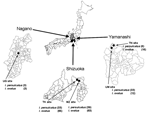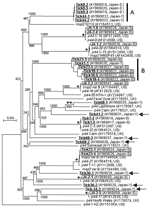Volume 11, Number 11—November 2005
Dispatch
Anaplasma phagocytophilum–infected Ticks, Japan
Abstract
We report Anaplasma phagocytophilum infection of Ixodes persulcatus and I. ovatus ticks in Japan. Unique p44/msp2 paralogs (and/or 16S rRNA genes) were detected in tick tissues, salivary glands, and spleens of experimentally infected mice. These findings indicate the public health threat of anaplasmosis in Japan.
Anaplasma phagocytophilum (formerly known as the agent of human granulocytic ehrlichiosis), Ehrlichia phagocytophila, and E. equi (1) are tickborne human pathogens of veterinary importance. They cause an emerging infectious and febrile systemic illness now known as human granulocytic anaplasmosis. The first case of human infection by A. phagocytophilum was reported in 1994 (2). Since then, an increasing number of cases have been recognized in the United States. Severities of this disease range from asymptomatic seroconversion to death, and severe illness is frequently documented. In Europe, the first human cases of this disease were described in 1997 (3), and serologic and polymerase chain reaction (PCR) analyses suggest that A. phagocytophilum is distributed throughout Europe and in some parts of the Middle East and Asia (4–6).
In nature, A. phagocytophilum is believed to be maintained in a tick-rodent cycle. The known vectors for this agent are Ixodes ticks, i.e., Ixodes scapularis and I. pacificus in the United States, I. ricinus mostly in Europe, and I. persulcatus in Russia (7) and China (5). Exposure to A. phagocytophilum–infected tick bites is the most common route of human infection, except for perinatal transmission or contact with infected mammalian blood (8,9).
In Japan, several Ixodes species, such as I. persulcautus, I. ovatus, and I. monospinosus, are potential vectors for transmission of Borrelia spp., Rickettsia spp., or Ehrlichia spp (10–12). However, little information is available regarding the ecologic and epidemiologic features of clinical cases of infection with A. phagocytophilum in Japan. We report infection with A. phagocytophilum in Ixodes ticks in central Japan determined by molecular epidemiologic approaches.
In 2003 and 2004, a total of 273 unfed and adult Ixodes ticks (114 I. persulcatus and 159 I. ovatus) were collected in central Japan (Figure 1). Of these, 123 live ticks were dissected, and DNA was isolated from whole tissues of 73 ticks and salivary glands of 50 ticks by using the QIAamp DNA mini kit (Qiagen Inc., Valencia, CA, USA). For detection of A. phagocytophlilum DNA, a nested PCR using primers designed based on the highly conserved region of p44/msp2 paralogs of (p3726 [5´-GCTAAGGAGTTAGCTTATGA-3´], p3761, p4183, and p4257) was conducted (12–14). Four (12.1%) of 33 I. persulcatus ticks collected at the Utsukushinomori (UM) site in Yamanashi Prefecture were positive by PCR (Table). Sixteen (7 I. persulcatus and 9 I. ovatus) (32%) of 50 salivary glands from ticks collected at the Takabachi and Mizugazuka sites in Shizuoka Prefecture were positive by PCR. Data indicated that I. persulcatus and I. ovatus in Japan are naturally infected with A. phagocytophilum and that ticks at certain sites are highly infected.
We further examined the infection of immunocompromised mice with A. phagocytophilum in ticks by using the procedure described previously (12). Briefly, whole tissues from 150 live ticks (55 I. persulcatus and 95 I. ovatus) were pooled and intraperitoneally injected into 15 ddY male mice (6–15 pooled ticks per mouse) treated with the immunosuppressant cyclophosphamide. PCR was conducted with DNA isolated from blood and spleens of these mice. Only 1 of 9 spleens from I. ovatus-injected mice was positive by PCR (Table). We previously detected Ehrlichia spp. DNA in I. ovatus–injected mice, but did not detect A. phagocytophilum DNA in I. ovatus– or I. persulcatus–injected mice (12) because we used only a few immunocompromised mice, i.e., most had normal immune systems. Thus, we treated all 15 mice used in the present study with cyclophosphamide. Results indicate that A. phagocytophilum in I. ovatus can be infective for immunocompromised mice, although the efficiency of infection was low (1/95 [1.1%]).
The p44/msp2 amplicons from 8 PCR-positive ticks and 1 PCR-positive mouse were cloned into a pCR2.1 vector with the TA Cloning Kit (Invitrogen, Carlsbad, CA, USA). Recombinant clones were randomly selected and 28 recombinant p44/msp2 clones were sequenced with an ABI 3100-Avant Genetic Analyzer (Applied Biosystems, Foster City, CA, USA). A phylogenetic tree was constructed based on the alignment of Japanese p44/msp2 sequences and the most closely related paralogs (220–400 bp) by using ClustalX (http://www-igbmc.u-strasbg.fr/BioInfo/ClustalX/), followed by the neighbor-joining method with 1,000 bootstrap resamplings (Figure 2). In this tree, the p44/msp2 sequences obtained from I. ovatus were located mostly in clusters different from those where sequences from I. persulcatus were located, except for Tick41-1. This finding suggests that A. phagocytophilum in I. ovatus may encode p44/msp2 paralogs distinct from those of A. phagocytophilum in I. persulcatus. A previous study suggested that the p44/msp2 sequences from the United States and the United Kingdom can be divided into 27 similarity groups based on >90% similarities of DNA sequences, and most sequences from the United Kingdom are distinguishable from those from the United State because of the similarities <79% (15). Of 28 Japanese p44/msp2 sequences in this study, 11 sequences with similarities >85.6% to the previously identified paralogs were probably divided into 8 similarity groups (Figure 2). Of the remaining 17 sequences with similarities <73.1%, 11 members that were grouped into 2 distinctive clusters (Figure 2) and 6 members that were individually located (Figure 2, arrows) were distinguishable from the 8 similarity groups. Thus, some p44/msp2 paralogs of Japanese A. phagocytphilum are unique and distinct from those of A. phgocytophlium in other countries, although multiple copies of p44 in the genome of an organism should be considered (13).
A partial sequence of the 16S rRNA gene of A. phagocytophilum (1.4 kb) from a p44/msp2 PCR-positive mouse was amplified from spleen DNA with primers ER5-3, ER-R1, AP-F1, and AP-R1 (12), cloned, and sequenced. Similarities among 6 Japanese recombinant 16S rRNA sequences (GenBank accession nos. AY969010–AY969015) were 99.3%–99.6%. When compared with A. phgocytophilum human agent U02521, the similarities were 99.6%–99.8% between individual 16S rRNA cloned sequences and human agent U02521. Because we used pooled ticks to examine infection in mice, these sequence diversities may depend on genetic variants (or a heterogeneous population) of A. phagocytophilum from individual ticks. When the amplicon was directly sequenced, its sequence was identical with that of human agent U02521.
We demonstrated that A. phagocytophilum infects Ixodes ticks in Japan, that both I. persulcatus and I. ovatus ticks are naturally infected with A. phgocytophilum, that A. phagocytophilum may be transmitted by Ixodes ticks because of organisms in the salivary glands of unfed and female adult ticks, and that immunocompromised mice can be infected with A. phagocytophilum. This study provides new information on the ecologic, biologic, and public health significance of A. phagocytophilum and emphasizes the threat of anaplasmosis in Japan.
Dr Ohashi is associate professor at the Institute for Environmental Sciences, University of Shizuoka, Japan. His primary research interests are molecular biology, ecology, and epidemiology of zoonotic parasites, particularly tickborne pathogens.
Acknowledgments
We thank Hiroki Kawabata for useful help in the field work.
This work was supported in part by grant H15-Shinkou-14 for research on emerging and reemerging infectious diseases from the Japanese Ministry of Health, Labor and Welfare to N.O. and T.M., grant H14-H15 from the Shizuoka Research Institute to N.O., and grant H14 from the president of the University of Shizuoka to N.O.
References
- Dumler JS, Barbet AF, Bekker CP, Dasch GA, Palmer GH, Ray SC, Reorganization of genera in the families Rickettsiaceae and Anaplasmataceae in the order Rickettsiales: unification of some species of Ehrlichia with Anaplasma, Cowdria with Ehrlichia and Ehrlichia with Neorickettsia, descriptions of six new species combinations and designation of Ehrlichia equi and 'HGE agent' as subjective synonyms of Ehrlichia phagocytophila. Int J Syst Evol Microbiol. 2001;51:2145–65. DOIPubMedGoogle Scholar
- Chen S-M, Dumler JS, Bakken JS, Walker DH. Identification of a granulocytotropic Ehrlichia species as the etiologic agent of human diseases. J Clin Microbiol. 1994;32:589–95.PubMedGoogle Scholar
- Petrovec M, Furlan SL, Zupanc TA, Strle F, Brouqui P, Roux V, Human disease in Europe caused by a granulocytic Ehrlichia species. J Clin Microbiol. 1997;35:1556–9.PubMedGoogle Scholar
- Keysary A, Amram L, Keren G, Sthoeger Z, Potasman I, Jacob A, Serologic evidence of human monocytic and granulocytic ehrlichiosis in Israel. Emerg Infect Dis. 1999;5:775–8. DOIPubMedGoogle Scholar
- Cao WC, Zhao QM, Zhang PH, Dumler JS, Zhang XT, Fang LQ, Granulocytic Ehrlichiae in Ixodes persulcatus ticks from an area in China where Lyme disease is endemic. J Clin Microbiol. 2000;38:4208–10.PubMedGoogle Scholar
- Heo EJ, Park JH, Koo JR, Park MS, Park MY, Dumler JS, Serologic and molecular detection of Ehrlichia chaffeensis and Anaplasma phagocytophila (human granulocytic ehrlichiosis agent) in Korean patients. J Clin Microbiol. 2002;40:3082–5. DOIPubMedGoogle Scholar
- Alekseev AN, Dubinina HV, van de Pol I, Schouls LM. Identification of Ehrlichia spp. and Borrelia burgdorferi in Ixodes ticks in the Baltic regions of Russia. J Clin Microbiol. 2001;39:2237–42. DOIPubMedGoogle Scholar
- Bakken JS, Krueth J, Lund T, Malkovitch D, Asanovich K, Dumler JS. Exposure to deer blood may be a cause of human granulocytic ehrlichiosis. Clin Infect Dis. 1996;23:198. DOIPubMedGoogle Scholar
- Horowitz HW, Kilchevsky E, Haber S, Aguero-Rosenfeld M, Kranwinkel R, James EL, Perinatal transmission of the agent of human granulocytic ehrlichiosis. N Engl J Med. 1998;339:375–8. DOIPubMedGoogle Scholar
- Masuzawa T, Okada Y, Yanagihara Y, Sato N. Antigenic properties of Borrelia burgdorferi isolated from Ixodes ovatus and Ixodes persulcatus in Hokkaido, Japan. J Clin Microbiol. 1991;29:1568–73.PubMedGoogle Scholar
- Fournier PE, Fujita H, Takada N, Raoult D. Genetic identification of rickettsiae isolated from ticks in Japan. J Clin Microbiol. 2002;40:2176–81. DOIPubMedGoogle Scholar
- Inayoshi M, Naitou H, Kawamori F, Masuzawa T, Ohashi N. Characterization of Ehrlichia species from Ixodes ovatus ticks at the foot of Mt. Fuji, Japan. Microbiol Immunol. 2004;48:737–45.PubMedGoogle Scholar
- Zhi N, Ohashi N, Rikihisa Y. Multiple p44 genes encoding major outer membrane proteins are expressed in the human granulocytic ehrlichiosis agent. J Biol Chem. 1999;274:17828–36. DOIPubMedGoogle Scholar
- Lin Q, Zhi N, Ohashi N, Horowitz HW, Aguero-Roenfeld ME, Raffalli J, Analysis of sequences and loci of p44 homologs expressed by Anaplasma phagocytophilum in acutely infected patients. J Clin Microbiol. 2002;40:2981–8. DOIPubMedGoogle Scholar
- Casey AN, Birtles RJ, Radford AD, Bown KJ, French NP, Woldehiwet Z, Groupings of highly similar major surface protein (p44)-encoding paralogues: a potential index of genetic diversity amongst isolates of Anaplasma phagocytophilum. Microbiology. 2004;150:727–34. DOIPubMedGoogle Scholar
Figures
Table
Cite This ArticleTable of Contents – Volume 11, Number 11—November 2005
| EID Search Options |
|---|
|
|
|
|
|
|


Please use the form below to submit correspondence to the authors or contact them at the following address:
Norio Ohashi, Laboratory of Environmental Microbiology, Institute for Environmental Sciences, University of Shizuoka, 52-1 Yada, Suruga, Shizuoka 422-8526, Japan; fax: 81-54-264-5793
Top